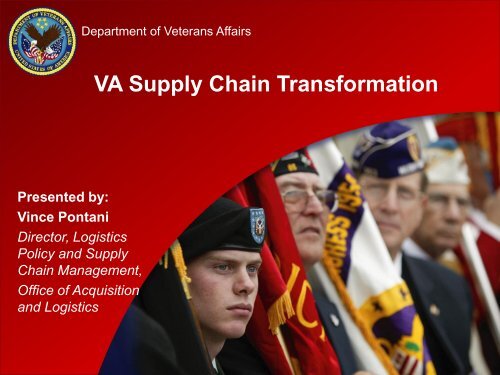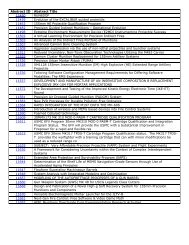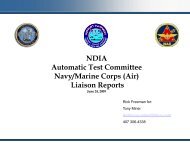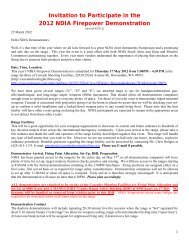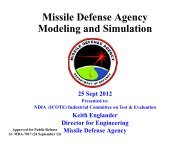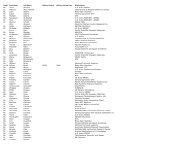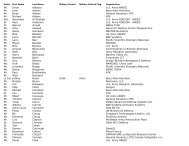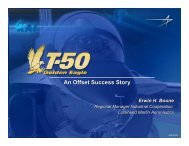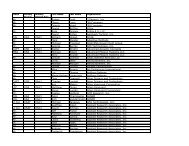VA Supply Chain Transformation - National Defense Industrial ...
VA Supply Chain Transformation - National Defense Industrial ...
VA Supply Chain Transformation - National Defense Industrial ...
You also want an ePaper? Increase the reach of your titles
YUMPU automatically turns print PDFs into web optimized ePapers that Google loves.
Presented by:<br />
Vince Pontani<br />
Director, Logistics<br />
Policy and <strong>Supply</strong><br />
<strong>Chain</strong> Management,<br />
Office of Acquisition<br />
and Logistics<br />
Department of Veterans Affairs<br />
<strong>VA</strong> <strong>Supply</strong> <strong>Chain</strong> <strong>Transformation</strong><br />
D
�Overview of <strong>VA</strong><br />
Briefing Outline<br />
�Why <strong>Supply</strong> <strong>Chain</strong> <strong>Transformation</strong> in <strong>VA</strong>?<br />
�<strong>VA</strong> <strong>Supply</strong> <strong>Chain</strong> Initiatives<br />
�<strong>VA</strong> SCM Modeling/Simulation Initiatives<br />
�<strong>VA</strong> Logistics/<strong>Supply</strong> <strong>Chain</strong> Education Initiatives
The Department of Veterans Affairs<br />
� FY 2010 Procurement Spend: ~$24 billion<br />
� FY 2010 Discretionary Budget Authority: $48 billion<br />
� FY 2011 Budget: $124 billion<br />
� FY 2011 Discretionary Budget Authority: $53 billion<br />
� Contract Actions – 232,649 (FY 2009)<br />
� Certified Contracting Officers in <strong>VA</strong> – 1700+ (Feb. 2010)<br />
� Targeting 5,000 + staff for Program/Project Management<br />
� <strong>VA</strong> Employees: 310,000+<br />
� VHA <strong>National</strong> Health Networks: 21<br />
� <strong>VA</strong> Hospitals: 153 (6 <strong>VA</strong>MCs under construction)<br />
� <strong>VA</strong> Community Based Outpatient Clinics: 900+<br />
� <strong>VA</strong> Veterans Centers: 232<br />
� VBA Regional Offices: 57<br />
� <strong>VA</strong> <strong>National</strong> Cemeteries: 131<br />
2
� <strong>Supply</strong> chain functions,<br />
organizations and systems<br />
reside in separate silos<br />
� There are 153 unique<br />
instances of the <strong>VA</strong><br />
procurement software;<br />
codes are non-standard<br />
� There are multiple <strong>VA</strong><br />
contracting entities and a<br />
variety of contract types.<br />
� No incentives for service<br />
providers to reduce costs<br />
� Demand forecasting and<br />
planning is not systemic<br />
� The acquisition process is<br />
not transparent to internal<br />
users or suppliers<br />
Why <strong>Supply</strong> <strong>Chain</strong> <strong>Transformation</strong>?<br />
Current Challenges<br />
Systems Stakeholders<br />
Outcomes<br />
� Per a recent survey, nearly<br />
half of internal customers<br />
are not satisfied with<br />
acquisition support<br />
� Program managers or<br />
buyers view paperwork<br />
burden as too high/not<br />
justified and most have<br />
experience of acquisition<br />
packages being rejected<br />
months after submission<br />
� Most <strong>VA</strong>MC managers do<br />
not have business<br />
management skills<br />
� At forums, suppliers said<br />
they perceive the<br />
acquisition process to be<br />
unclear and not applied in a<br />
standard manner<br />
� Escalating annual spend on<br />
healthcare and related<br />
commodities reached $28<br />
billion in 2010 1<br />
� Purchase orders increased<br />
18% from FY08 to FY10 –<br />
(4.7 million POs in FY10) 1<br />
� A high degree of “spend<br />
fragmentation” – <strong>VA</strong> has<br />
more than 30,000 suppliers<br />
and 210,993 contracts 2<br />
� In past five years, 35 <strong>VA</strong><br />
OIG reports citing missed<br />
savings and improper<br />
management 3<br />
� Low utilization of national<br />
contracts and blanket<br />
purchase agreements 4<br />
Sources: 1-MedPDB; 2- eCMS; 3-<strong>VA</strong> OIG; 4-NAC reports<br />
3
“<strong>Supply</strong> chain generally<br />
accounts for between 60% and<br />
90% of all company costs.”<br />
– <strong>Supply</strong> <strong>Chain</strong> Council, 2010<br />
“A 2 percent improvement in<br />
supply chain process<br />
efficiency has 30 to 50 times<br />
the impact of a 2 percent<br />
improvement in efficiency<br />
for… IT… HR… Finance …<br />
Sales…”<br />
– <strong>Supply</strong> <strong>Chain</strong> 2006 SCM Benchmark<br />
data on SCM cost for discrete & process<br />
industries<br />
<strong>Supply</strong> <strong>Chain</strong> Management is a Key Driver<br />
of Organizational Performance<br />
“Most hospitals … have an opportunity to<br />
reduce supply-chain expenses by as much as 15<br />
percent through internal initiatives.”<br />
– Healthcare Financial Management, Jan 2004 by Robert N. Davis<br />
The <strong>Supply</strong> <strong>Chain</strong> Impacts The Knobs and Levers Program Value<br />
� Improve customer service<br />
and response<br />
� Optimize inventory flow,<br />
utilization, & productivity<br />
� Best-in-class customer<br />
relationships<br />
� Differentiated service<br />
capabilities<br />
� Best-in-class strategic<br />
supplier partnerships<br />
� Leverage of outsourcing of<br />
business processes<br />
� Unique supply chain<br />
models<br />
<strong>Supply</strong> <strong>Chain</strong> is Directly Connected to<br />
Organization Value<br />
Revenue<br />
Expense<br />
Working<br />
Capital<br />
Fixed Capital<br />
Profit<br />
Capital<br />
Efficiency<br />
Value<br />
<strong>Supply</strong> <strong>Chain</strong> Council, 2010<br />
4
Contracts<br />
� Redundant functions<br />
� Out-of-sync processes<br />
� Organizational disconnects<br />
<strong>VA</strong> <strong>Supply</strong> <strong>Chain</strong> is Functional<br />
but Not Aligned for Mission Efficiency<br />
Current State Desired Future State<br />
Inventory<br />
Requirements<br />
Alignment of roles, responsibilities, processes,<br />
decision making & information flow:<br />
� Policy, Guidance and Oversight<br />
� Integrated Communications<br />
� Data Management, Analysis and Reporting<br />
� Performance Management<br />
� Human Capital Strategies<br />
Benefits of a coordinated supply chain include: collaboration among units;<br />
reduced impacts of silos on performance; improved communications, decision<br />
making and role clarity; and improved performance against mission requirements<br />
Requirements<br />
Contracts<br />
Order Processing<br />
Requisition/Invoice<br />
Policy, Guidance and Oversight<br />
Integrated Communications<br />
Data Management, Analysis and Reporting<br />
Performance Management<br />
Human Capital Strategies<br />
Inventory<br />
Resources<br />
Supplier Management
<strong>VA</strong> <strong>Transformation</strong> Initiatives to Achieve<br />
<strong>VA</strong> “Perfect Order Fulfillment” (POF)<br />
� 360 0 Customer Satisfaction KPI<br />
� Internal Acquisition Customers<br />
� <strong>VA</strong> Supplier Outreach<br />
� <strong>VA</strong>/VHA Logistics <strong>Transformation</strong><br />
� Strategic Sourcing/Acquisition<br />
� Acquisition Realignment<br />
� <strong>VA</strong> SCOR Model<br />
POF: Providing the right item/service<br />
� At the right place<br />
� At the right (or needed) time<br />
� To meet the Veteran need<br />
� Functioning properly<br />
� At the “right” cost
�<br />
�<br />
�<br />
�<br />
Strategies<br />
Spend Analysis<br />
&<br />
Strategic<br />
Sourcing<br />
<strong>Supply</strong> <strong>Chain</strong><br />
Process<br />
Improvement<br />
using SCOR<br />
Internal<br />
Customer and<br />
Supplier<br />
<strong>Transformation</strong><br />
Communications<br />
and Change<br />
Management<br />
<strong>VA</strong> <strong>Supply</strong> <strong>Chain</strong> <strong>Transformation</strong><br />
Near and Mid-Term Strategies<br />
�Detailed savings hypothesis<br />
�Macro and micro data analysis<br />
�Business case development<br />
�Internal customer satisfaction surveys<br />
�Supplier Perception Surveys<br />
Activities Objectives<br />
�Baseline supply chain processes and metrics<br />
�Define future state <strong>VA</strong> supply chain processes<br />
�Link supply chain metrics to <strong>VA</strong> mission/goals<br />
�Action plans to address issues and improvements<br />
�Conduct stakeholder assessments<br />
�Create channels for acquisition workforce<br />
�Build awareness and understanding<br />
“Quick Win” Savings<br />
Opportunities with<br />
Valid Business Cases<br />
Consistent and<br />
Efficient Business<br />
Processes<br />
Internal<br />
Improvements<br />
Supplier<br />
Collaboration<br />
Ready, Willing and<br />
Able Stakeholders<br />
�<br />
�<br />
�<br />
�
<strong>VA</strong> Hypothesis-Driven<br />
Strategic Sourcing Methodology
HCS Portfolio<br />
IT Products = $225,924,243<br />
IT Services = $1,111,368,394<br />
Other = $900,000,000<br />
Portfolio Teams Conduct<br />
Focused Macro & Micro Analysis<br />
Med/Surg Portfolio<br />
IT Portfolio<br />
IT Products<br />
IT Services<br />
Plumbing &<br />
H<strong>VA</strong>C<br />
$72.6M<br />
8%<br />
Non-Construction<br />
Commodity Spend<br />
6%<br />
5%<br />
11%<br />
EXAMPLE<br />
CFM Portfolio<br />
70%<br />
Building Support<br />
Services*<br />
$610.5M
Portfolio Teams Visit<br />
Field Locations to Develop Opportunities<br />
Locations visited<br />
� VISN 22<br />
– West Los Angeles,<br />
Long Beach<br />
� VISN 21<br />
– San Francisco, Palo<br />
Alto<br />
� VISN 20<br />
– Seattle, Portland<br />
� VISN 17<br />
– Dallas, Temple, San<br />
Antonio, Harlingen<br />
� VISN 16<br />
– Houston, Biloxi,<br />
Jackson, Little Rock<br />
� VISN 6<br />
– Richmond<br />
� VISN 7<br />
– Atlanta, Augusta<br />
� VISN 5<br />
– Washington, DC<br />
� VISN 3<br />
– Bronx<br />
� Acquisition Centers<br />
– NAC, Hines, IL<br />
– TAC, Eatontown, NJ<br />
– Austin TX Information<br />
Technology Center<br />
10
Teams Develop Supporting Business Cases<br />
EXAMPLE: Diagnostic Imaging Procedures<br />
Spend Analysis Business Case Summary<br />
� Potential for $130M-150M* in annual cost avoidance<br />
� Comprehensive lifecycle management<br />
� Enhanced enterprise-wide planning and coordination for the acquisition of<br />
new equipment<br />
� Greater clinician voice in developing requirements can improve patient<br />
care<br />
Low High<br />
Ben $100,000,000 $145,000,000<br />
Cost $7,111,660 $7,111,660<br />
Net Ben $92,888,340 $137,888,340<br />
ROI 13X 19X<br />
Recommendation<br />
� Establish a Program Management Office for Diagnostic<br />
Imaging and Nuclear Medicine<br />
– First initiative is implementation of a Radiology decision<br />
support capability that integrates with CPRS<br />
– Long term PMO benefits: Total Lifecycle Management<br />
(Total Ownership Cost), provides a single source for<br />
equipment acquisition management, supports <strong>VA</strong> goal of<br />
professionalizing the acquisition of workforce
Source: SCC<br />
The <strong>Supply</strong> <strong>Chain</strong> Operations Reference<br />
(SCOR) Model Provides A Baseline<br />
Deliver<br />
Suppliers’<br />
Supplier<br />
Source<br />
Return Return<br />
Make<br />
Supplier<br />
� SCOR takes the segments of a supply chain, identifies the players within each segment and the processes<br />
they perform, and then shows the interrelationships of these processes.<br />
� There is a material flow, an information flow, and a cash flow associated with these processes.<br />
SCOR provides…<br />
Deliver<br />
� Standard processes:<br />
Plan, Source, Make, Deliver, Return,<br />
Enable<br />
� Standard metrics:<br />
Perfect Order Delivery, <strong>Supply</strong>-<strong>Chain</strong><br />
Cost, etc.<br />
� Best practices<br />
EDI, CPFR, etc.<br />
� Pre-defined relationships among<br />
processes, metrics and practices<br />
Plan<br />
Source Make Deliver Source Make Deliver<br />
<strong>VA</strong><br />
VBA VHA NCA OAL<br />
Service<br />
Providers<br />
SCOR allows…<br />
Source<br />
Return Return Return Return Return Return<br />
Veterans<br />
�Common supply chain terminology that<br />
translates across industries and<br />
organizations, which permits:<br />
–Meaningful benchmarking with other<br />
organizations<br />
–Common metrics for performance<br />
assessment and comparison<br />
–Incorporation of industry best<br />
practices to improve supply chain<br />
performance
Enable <strong>Supply</strong> <strong>Chain</strong><br />
SCOR Activities<br />
P = Plan<br />
S = Source<br />
M = Make<br />
D = Deliver<br />
R = Return<br />
E = Enable<br />
<strong>VA</strong>AA<br />
SDC<br />
Transactions<br />
Formal Relationships<br />
P<br />
EP ES<br />
OAL ES S<br />
ER<br />
MBR<br />
Pharm<br />
Current <strong>VA</strong> <strong>Supply</strong> <strong>Chain</strong><br />
Organizational Relationships<br />
IT CFM<br />
Center for<br />
Acquisition<br />
Innovation<br />
Suppliers<br />
<strong>National</strong><br />
Acquisition<br />
Center<br />
Denver<br />
Acq & Logistics<br />
Technology<br />
Acquisition<br />
Center<br />
HCS<br />
Med/<br />
Surg<br />
<strong>VA</strong>CO<br />
Center<br />
Regional<br />
Contract Center<br />
Veterans<br />
P<br />
ES EP<br />
VBA<br />
OAL<br />
VHA NCA<br />
S<br />
P<br />
M<br />
R<br />
D<br />
Benefit Offices/<br />
Centers<br />
D<br />
R OAL<br />
S<br />
Administrations<br />
Service Providers<br />
Hospitals/<br />
Clinics Cemeteries
D<br />
R<br />
Supplier<br />
D<br />
R<br />
Supplier<br />
D<br />
R<br />
Supplier<br />
D<br />
R<br />
Supplier<br />
Supplier’s<br />
Supplier<br />
Oversight<br />
Transactions<br />
Requirements<br />
SCOR - <strong>VA</strong> Medical/Surgical <strong>Supply</strong> <strong>Chain</strong><br />
(with SCOR activity indicators)<br />
S<br />
R<br />
D<br />
Prime<br />
Vendor<br />
ES S<br />
ER<br />
Regional<br />
Contract<br />
Center<br />
ES S<br />
ER<br />
CAI<br />
ES S<br />
ER<br />
DALC<br />
ES S<br />
ER<br />
TAC<br />
ES S<br />
ER<br />
NAC<br />
P<br />
EP ES<br />
VHA<br />
P<br />
EP ES<br />
OAL<br />
EP<br />
ES EM<br />
VISN 1<br />
VISN 2<br />
VISN 3<br />
…VISN 21 23<br />
Supplier Strategic-Level<br />
EP ES<br />
OI&T<br />
GOODS and SERVICES<br />
$$$/POLICY/GUIDANCE<br />
INFORMATION and REQUIREMENTS<br />
S<br />
P<br />
M<br />
R<br />
D<br />
CLCP<br />
P&SA<br />
Clinic<br />
Orth/Pros<br />
Lab<br />
Out<br />
Patient<br />
Clinic<br />
Hospital<br />
<strong>VA</strong>MC<br />
Customer<br />
Customer’s<br />
Customer<br />
Veteran
<strong>VA</strong> Supplier Relationship<br />
“Voice of the Customer” Initiatives<br />
� Regional Supplier Relationship Forums<br />
� Federal <strong>Supply</strong> Schedule Forums<br />
� Supplier Perception Survey<br />
� <strong>VA</strong> Industry Advisory Group<br />
15
<strong>VA</strong> Supplier Relationship <strong>Transformation</strong><br />
Forums Since August 2009<br />
� Washington, DC – August 2009<br />
�New Brunswick, NJ – August 2010<br />
�Long Beach, CA – August 2010<br />
�Chicago, IL – October 2010 (2 – SRT & FSS)<br />
�Tampa, FL – May 2011<br />
�Washington, DC – June 2011 (Construction & Fac)<br />
�San Francisco, CA – September 2011<br />
�Chicago, IL – October 2011* (2 days)<br />
�Houston, TX – November 2011*<br />
� * Planned Forums<br />
16
<strong>VA</strong> Supplier Relationship <strong>Transformation</strong><br />
Forums - What We Did<br />
�Small facilitated breakout group sessions<br />
�Discussed what does and does not work with <strong>VA</strong>’s<br />
acquisition process<br />
�Forum attendees were separated into industry groups<br />
�Building, Construction, Design, and Engineering<br />
�Medical Equipment and Supplies<br />
�Pharmaceuticals<br />
�Information Technology Management<br />
�Business Management and Administrative Services<br />
17<br />
17
<strong>VA</strong> Supplier Relationship <strong>Transformation</strong><br />
Forums - What We Heard<br />
Theme Key Points from Suppliers<br />
Communications<br />
Customer<br />
Service<br />
Team Work<br />
Contracting<br />
Process<br />
Performance<br />
Communication and transparency surrounding the acquisitions process<br />
need improvement, both internally and externally.<br />
Suppliers would like to see enhancements to the level and quality of<br />
acquisition support they receive – e.g., calls returned, modifications<br />
addressed in a timely manner.<br />
Suppliers would like to be provided with clear definitions of the roles and<br />
responsibilities of the contracting officer, the Contracting Officer’s<br />
Technical Representative, and the Program Manager in order to better<br />
differentiate among them.<br />
Suppliers want to provide <strong>VA</strong> with expertise during the Requests for<br />
Information process to ensure <strong>VA</strong> is using the correct contract type and<br />
definition of requirements in order to give <strong>VA</strong> the best price and delivery<br />
timeline.<br />
Suppliers would like a system to be in place for them to offer feedback on<br />
requirements and the contract process.<br />
18
<strong>VA</strong> Federal <strong>Supply</strong> Schedule (FSS)<br />
Forum - What We Did<br />
�2 day FSS Forum with 191 participants<br />
�Discussed what does and does not work with <strong>VA</strong> FSS<br />
process and the re-engineered business processes at the<br />
<strong>National</strong> Acquisition Center (NAC)<br />
�Small facilitated breakout group sessions based on the<br />
following schedules<br />
�621I - Professional and Allied Healthcare Staffing Services<br />
�651B - Drugs, Pharmaceuticals, and Hematology Related Products<br />
�65IIA - Medical Equipment and Supplies<br />
�65IIC - Dental Equipment and Supplies<br />
�65VII - In-vitro Diagnostics, Reagents, Test Kits and Test Sets<br />
19
<strong>VA</strong> Federal <strong>Supply</strong> Schedule (FSS)<br />
Forum - What We Heard<br />
Theme Key Points from Suppliers<br />
Communications<br />
Customer Service<br />
Contracting<br />
Workforce<br />
Contracting Process<br />
Awards<br />
Communicating with <strong>VA</strong> proves to be a continuous problem and quality<br />
of communications has only declined since the business process<br />
changes at the NAC<br />
– Suppliers do not know whom to contact for various needs<br />
– There is a need for a single, responsive <strong>VA</strong> Point of Contact<br />
Suppliers would like to see enhancements to the level and quality of<br />
acquisition support they receive – e.g., calls returned, modifications<br />
addressed in a timely manner.<br />
Contracting workforce needs training on policies, legislation,<br />
processes, prioritization, and scenarios<br />
Delays have increased in the past year, including contract<br />
modifications, getting on a schedule, and other tasks within the<br />
acquisition process<br />
Suppliers are left in the dark when it comes to information regarding<br />
whether work was awarded, to whom, and for what price<br />
20
<strong>VA</strong> Supplier Relationship Webinars<br />
�December 2009 Webinar<br />
�325 Attendees – all commodity areas<br />
�Opening and closing remarks by <strong>VA</strong> Deputy Secretary<br />
�Overview by <strong>VA</strong> CAO and SPE<br />
�February 2011 Webinar<br />
�934 Attendees – all commodity areas<br />
�Opening and closing remarks by <strong>VA</strong> Deputy Secretary<br />
�Overview by <strong>VA</strong> CAO and SPE<br />
�Update on <strong>VA</strong> “Voice of The Customer” Initiatives<br />
�Overview of <strong>VA</strong> Education Initiatives<br />
�Update on <strong>VA</strong> HCA Action Plans<br />
�Live Question & Answer Session & “Tweeting”<br />
21
<strong>VA</strong> Supplier Perception Survey<br />
�Developed at Department of <strong>Supply</strong> <strong>Chain</strong> Management,<br />
Eli Broad Graduate School of Business, Michigan State<br />
University<br />
�Perception Survey based on 5-point Likert Scale<br />
�32 Standard Questions with Open Comment Areas<br />
�Required OMB Approval (Paperwork Reduction Act)<br />
�Administered on a Semi-Annual Basis<br />
�Data and Analysis Provided by Michigan State University<br />
�Focused on Improving “Supplier Perception Score” (SPS)
Value / Innovation<br />
15<br />
10<br />
5<br />
0<br />
-5<br />
-10<br />
-15<br />
Supplier Perception Survey<br />
SPS Impact on Value / Innovation<br />
1 2 3 4 5<br />
Value / Innovation<br />
Supplier Perception Score
Total Cost of Ownership<br />
15<br />
10<br />
5<br />
0<br />
-5<br />
-10<br />
-15<br />
TCO<br />
Supplier Perception Survey<br />
SPS Impact on TCO<br />
1 2 3 4 5<br />
Supplier Perception Score
6.2%<br />
11.4%<br />
29.6%<br />
43.1%<br />
9.9%<br />
Supplier Perception Survey<br />
Selected Respondent Demographics<br />
<strong>VA</strong> as a % of Supplier Revenue<br />
1.1%<br />
42.8%<br />
Years as a <strong>VA</strong> Supplier<br />
16.2%<br />
39.6%<br />
Less than 5%<br />
5 to 25%<br />
25 to 50%<br />
50 to 75%<br />
More than 75%<br />
Less than 1<br />
1 to 3<br />
3 to 10<br />
10 or more<br />
� For nearly 43% of respondents, <strong>VA</strong><br />
accounts for less than 5% of their<br />
revenue.<br />
� 42.1% of respondents have done<br />
business with <strong>VA</strong> for 10 or more<br />
years.<br />
� Nearly 8 out of 10 respondents<br />
have a current contract with <strong>VA</strong>.<br />
100%<br />
80%<br />
60%<br />
40%<br />
20%<br />
0%<br />
Current <strong>VA</strong> Contract?<br />
78.9%<br />
21.1%<br />
Yes No
<strong>VA</strong> Supplier Perception Survey<br />
Overarching Satisfaction Ratings<br />
Extent to which <strong>VA</strong> provides an effective interface<br />
between its management and yours<br />
Extent to which <strong>VA</strong> makes it easy for you to succeed<br />
in effectively providing the goods and services they …<br />
<strong>VA</strong>'s overall procurement process<br />
Your commitment to <strong>VA</strong> for a long term business<br />
relationship<br />
<strong>VA</strong>'s commitment to you for a long term business<br />
relationship<br />
The overall quality of the working relationship<br />
between <strong>VA</strong> and your company<br />
<strong>VA</strong>'s processes to allow you to provide best value<br />
3.6%<br />
28.7%<br />
40.7%<br />
30.6%<br />
28.4%<br />
35.0%<br />
36.6%<br />
26.3%<br />
34.5%<br />
39.2%<br />
26.3%<br />
38.9%<br />
37.0%<br />
24.0%<br />
47.2%<br />
34.1%<br />
18.7%<br />
24.0%<br />
43.5%<br />
32.5%<br />
% Positive<br />
% Neutral<br />
% Negative<br />
70.1%<br />
0% 10% 20% 30% 40% 50% 60% 70% 80%<br />
26
<strong>VA</strong> Supplier Perception Survey<br />
Highest Rated Dimensions<br />
Question 2 nd Survey Initial Survey<br />
Your commitment to <strong>VA</strong> for a long term business relationship 4.04 (656) 4.0<br />
<strong>VA</strong>'s record in honoring contract payment terms 3.62 (641) 3.55<br />
<strong>VA</strong>’s integrity 3.55(664) 3.47<br />
The overall quality of the working relationship between <strong>VA</strong> and your<br />
company<br />
3.5 (660) 3.42<br />
<strong>VA</strong>'s emphasis on quality and commitment to continuous improvement 3.29 (619) 3.2<br />
� Four questions were rated 3.5 and higher while during<br />
initial survey only two questions were rated 3.5 and higher<br />
� Key indicators of trust between <strong>VA</strong> and suppliers going up<br />
27
<strong>VA</strong> Supplier Perception Survey<br />
Lowest Rated Dimensions<br />
Question 2 nd Survey Initial Survey<br />
<strong>VA</strong>'s concern for your profitability 2.78 (591) 2.8<br />
<strong>VA</strong>'s ability to present "one face" in your dealings across multiple functions 2.87 (619) 2.75<br />
<strong>VA</strong>'s effectiveness in sharing risk, reducing your need to build risk into<br />
your pricing<br />
2.88 (549) 2.81<br />
<strong>VA</strong>'s effectiveness in focusing on Total Cost of Ownership 2.89 (530) 2.85<br />
<strong>VA</strong>’s processes allow you to provide best value 2.93 (629) 2.85<br />
� 10 of the 32 questions received an average rating of under<br />
3.0 on a 5.0 satisfaction scale. This is an improvement<br />
from 17 questions that received below 3.0 in the first<br />
survey.<br />
� It is a positive sign that 2.78 is the lowest average rating<br />
received, which again is better than the 2.75 rating<br />
received in the first survey.<br />
28
Supplier Perception Survey<br />
Analysis<br />
�Favorable ratings are extremely encouraging.<br />
�Key areas for <strong>VA</strong> to work on:<br />
�Poor consistent interface – “Single Face” to industry<br />
�Understanding and appreciation for:<br />
�Open, collaborative cost management<br />
�Strategic cost elimination (Total Cost of Ownership)<br />
29
Supplier Relationship <strong>Transformation</strong><br />
<strong>Transformation</strong>al Objectives<br />
� Clear, Timely Communication<br />
� Accountability for Customer Service<br />
� Teamwork and Collaboration<br />
� Contract Process Improvements<br />
� Professionalism and Excellence<br />
30
<strong>VA</strong> Supplier Relationship <strong>Transformation</strong><br />
Ongoing Actions<br />
�Focused HCA Action Plans - 2 Key Themes<br />
� Communications training<br />
� Customer service training<br />
�Real-time internal & external customer feedback mechanism<br />
� Virtual Office of Acquisition<br />
� Social Media (Facebook, Twitter, BLOG)<br />
�<strong>VA</strong> Innovation Initiative (<strong>VA</strong>I2) – internal & external<br />
� <strong>VA</strong> 16 Major Initiatives<br />
� BAA for Key Requirements<br />
�<strong>VA</strong> Industry Advisory Group – Michigan State University<br />
�FY2012 and Beyond<br />
� Forums<br />
� Webinars<br />
� Surveys<br />
� Industry-focused Working Groups
<strong>VA</strong> Industry Advisory Group<br />
� Coordinated through the Ambit Group and Michigan State University<br />
Eli Broad School of Business<br />
� Comprised of a variety of business sizes and types (24 companies)<br />
� IAG Goals<br />
� Be relevant for <strong>VA</strong> senior management.<br />
� Share best practices & success stories<br />
� Provide structured suggestions to enable better supplier relations<br />
� Initial meeting held July 22, 2011<br />
� Future focus areas<br />
� Relationship formation<br />
� Transform <strong>VA</strong> and industry culture<br />
� Standardization<br />
32
<strong>VA</strong> <strong>Supply</strong> <strong>Chain</strong> <strong>Transformation</strong><br />
Requires Total Stakeholder Engagement<br />
<strong>VA</strong> Service Providers<br />
1. Program Managers<br />
2. Clinical staff<br />
3. Facility management & local IT support<br />
4. Central Business Office (CBO)<br />
5. Facilities Directors and CFOs<br />
6. VISN Clinical Directors and CFOs<br />
7. VHA DUSHOM & Senior Clinicians<br />
<strong>VA</strong> Acquisition Workforce<br />
1. Contracting Officers and Managers<br />
2. Chief Logistic Officers<br />
3. Material Managers<br />
4. <strong>National</strong> & Regional acquisition centers<br />
(NAC/TAC/CAI/DALC)<br />
5. Regional VBA Office Procurement<br />
Managers<br />
6. Office of Information & Technology (OI&T)<br />
<strong>VA</strong> Leadership<br />
1. SEC<strong>VA</strong>, DEPSEC<strong>VA</strong>, SRG/SMC<br />
2. OALC Leadership & Portfolio Managers<br />
3. VHA PLO<br />
4. VBA & NCA Logistics<br />
Suppliers/Partners<br />
1. Suppliers – Health-care services<br />
2. Suppliers – Med/Surg equipment<br />
3. Suppliers – Information Technology<br />
4. Suppliers – Construction and Maintenance<br />
5. Suppliers – All material & services<br />
6. General Services Agency (GSA)<br />
7. Small Businesses, VOSBs and SDVOSBs<br />
External Stakeholders<br />
1. Affiliated medical schools<br />
2. Veteran Service Organizations (VSOs)<br />
3. Office of Management and Budget (OMB)<br />
4. Congress<br />
5. Watchdog groups<br />
6. Media<br />
33
<strong>Supply</strong> <strong>Chain</strong> Modeling and Simulation<br />
� <strong>VA</strong> <strong>Supply</strong> <strong>Chain</strong> Game<br />
� <strong>VA</strong> Strategic Sourcing Game
<strong>VA</strong> <strong>Supply</strong> <strong>Chain</strong> Game<br />
Designed to orient leaders to the implications of strategic<br />
supply chain management decisions<br />
Description<br />
� A game on coordinating supply chain<br />
functions - starting in the middle of someone<br />
else's mess.<br />
� The players are supposed to fulfill<br />
commodity demand as it comes due. They<br />
have the option of working directly on a<br />
single commodity or, by transforming<br />
operations, improving all the commodities at<br />
once.<br />
� The board shows demand forecast across a<br />
planning horizon in time-based increments.<br />
There are multiple actors representing<br />
segments of <strong>VA</strong> that can move<br />
independently in each turn to improve some<br />
aspect of operations or to fulfill demand.<br />
� The game ends when the facilitator says,<br />
“Time up” and the winning team has the<br />
most points. Points are gained by fulfilling<br />
demand and they’re maximized by making<br />
stakeholders happy. Points are lost by<br />
using resources.<br />
� Learning Curve<br />
– 15 minutes<br />
� Playing Time<br />
– 1 hour<br />
� Number of Players<br />
– Solitaire or Team<br />
play<br />
� Support<br />
– Requires a<br />
facilitator, or<br />
players who have<br />
played before
� <strong>VA</strong> KnowNet-2<br />
Logistics/<strong>Supply</strong> <strong>Chain</strong> Education<br />
� Interactive Web-Portal access<br />
� <strong>VA</strong> Threaded/interactive Personal Property Desk Reference<br />
� 700 <strong>VA</strong> Property Managers Registered to Date<br />
� <strong>VA</strong> Catalog 3 (Section V) – Category Stock Numbers (CSNs)<br />
� <strong>VA</strong> Specific Logistics Training Courses<br />
� Other initiatives (CoP, best practices, links, etc.)<br />
� School of Logistics & <strong>Supply</strong> <strong>Chain</strong> Management<br />
� Authorization for FY2012<br />
� Logistics Workforce Competency Assessment<br />
� Competency Mapping<br />
� Resident & Distance Learning Course Development
Log/SCM <strong>Chain</strong> Education – Academic Offerings<br />
�Michigan State University, E. Lansing MI<br />
� <strong>Supply</strong> <strong>Chain</strong> Logistics Management<br />
� Purchasing and <strong>Supply</strong> <strong>Chain</strong> Management<br />
� MS SCM and Certificate Programs<br />
�Arizona State University – Phoenix AZ<br />
� MS SCM and Certificate Programs<br />
� MBA <strong>Supply</strong> <strong>Chain</strong> Student Research Opportunities<br />
� Institute for <strong>Supply</strong> Management (ISM) affiliation<br />
�UNC Chapel Hill – Institute for <strong>Defense</strong> & Business<br />
� Advanced Program in Logistics & Technology (LOGTECH Advanced)<br />
� Logistics for The 21 st Century (Log21)<br />
� Life Cycle Executive Leadership Program (LCELP)<br />
� Logistics Cooperation for Stabilization and Reconstruction (LCSR)<br />
� LOGTECH MBA<br />
�Naval Postgraduate School, Monterrey CA<br />
� Logistics 101 Operations Management Course
Long-Term: Logistics Career - FAC-L<br />
<strong>VA</strong> FAC-L Level 1<br />
Logistics workforce that can provide<br />
the full range of logistics support and<br />
capabilities at a facility, organizational,<br />
and entity level throughout the <strong>VA</strong>.<br />
<strong>VA</strong> FAC-L Level 2<br />
Logistics workforce that can provide<br />
technical and supervisory levels of<br />
support spanning the full range of<br />
logistics capabilities at facility, network,<br />
regional, administration, and central<br />
office levels throughout the <strong>VA</strong>.<br />
<strong>VA</strong> FAC-LLevel 3<br />
<strong>Supply</strong> chain & logistics workforce that<br />
can provide operational and strategic<br />
supervisory and planning support<br />
spanning the full range of supply chain<br />
management at regional, network,<br />
administration, and central office levels<br />
throughout the <strong>VA</strong>
� Vincent Pontani<br />
– Vincent.pontani@va.gov<br />
– 202-429-7139<br />
QUESTIONS?


